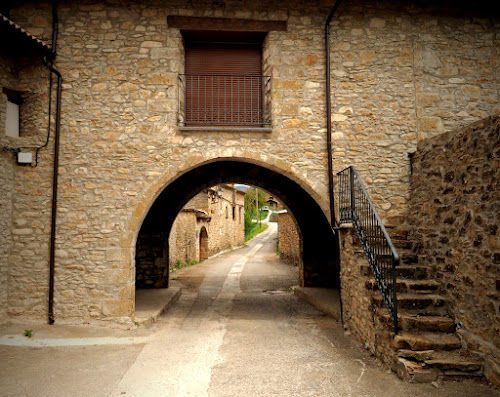Excuse us if we emerged from our hotel in downtown Sabinanigo looking a bit bewildered this morning. Someone decided to turn on the radio speakers in our room, at top volume, at exactly 6am. So we woke up to an overly cheerful singer I didn't recognise trying to convince us to be "happy, happy, happy". At the ungodly hour of six in the morning. How that happened remains a mystery, but it got us out of bed and on the road at just after seven, considerably earlier than our usual time.
We've been walking for nine days and have never once seen other pilgrims. Well, there was the group of Dutch people outside Betharram but it was a fleeting glimpse, they were on another route. We love the quiet solitude of this section of the Camino so far. It's been a journey of magic, beautiful nature, history and good food.
It was an easy walk throughout the day. It started with a climb out of the valley to the sleepy village of Alto Sabinanigo. The village seemed quite poor - you can tell the status of a village's inhabitants by the state of its parish church. Here the church was of basic design with few adornments and in dire need of restoration. Its grounds were overgrown and unkept. However, a few kilometres further we spent a few minutes in Ulle, a model, gentrified village if ever there is one. Unfortunately the church was locked but it was just a little too grand for the size of the village it stood in, had clearly been restored more than once, and its massive wooden doors were gleaming with a fresh coat of varnish. Everywhere tidy fences sported neatly trimmed rose hedges. Even the village mongrel looked well-groomed. Clearly there's a land developer or a kind benefactor at work here.
Speaking of village life. All towns we've walked through has a local stud. In Alto Sabinanigo it was a gorgeous if slightly scruffy ginger tom cat who posed for a photo in the nook of an old fig tree. Five steps further three kittens ran across the alley, all of them exactly the same shade of ginger. A little further we saw another, and then another one with white paws. Clearly this is a family affair happening here. And we could see who was in charge.
We walked into Jaca around 3pm, and culture vultures we are, headed straight for the cathedral. It was exhibiting a brilliant collection of ancient, pre-gothic-era wall art saved from various smaller and neglected churches in the Jaca district. The walls of almost all of the small parish churches we've seen have bare walls, but back in the day they were colourfully decorated in the style typical the time with biblical images and depictions of saints. Thankfully archeological research have discovered many of these decorations, probably hidden under layers of newer paint, and saved them for posterity here.
Many people may shake their heads at such displays of odd bits of faded art, but I stood in wonder for at least two hours, imagining the lives of these unknown artists who painstakingly mixed pigments with which to decorate the walls of churches that are now in danger of disappearing altogether. This is after all what the Camino is about for me. Remembrance.




































